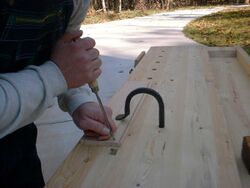Engineering:Holdfast (tool)
 A carpenter using a holdfast | |
| Other names | Hold fast, hold-down |
|---|---|
| Used with | Woodworking workbench or anvil |
A holdfast or hold fast is a form of temporary clamp used to hold a workpiece firmly to the top or side of a wooden workbench or the top of an anvil.[1]
A form of bench dog, a traditional holdfast has either a curved or flat top. Its shank is slid loosely into a “dog” hole in the bench or anvil until the tip of its hook touches the work. It is set by hitting its top with a mallet or hammer, which causes the shaft to wedge tightly against the sides of the hole. A tap of its back side near the top releases it.
Contemporary holdfasts are commonly designed to fit in 3⁄4 inch (19 mm) holes, somewhat narrower than had been traditional.[2] Scrap pieces of wood or leather are often used between the holdfast and the workpiece to prevent marring it.
An adaptation of the holdfast is threaded, sometimes known as a “screwdown”, which is tightened rather than tapped in place.[3]
History
Based on a fresco discovered in the ruins of Herculaneum, holdfasts are known to have been in use since at least the 1st century AD.[4] They are also described and illustrated in early European books on woodworking, such as Joseph Moxon's 1678 edition of Mechanick Exercises and André Jacob Roubo's 1774 L'Art du Menuisier.[5][6] The term has been in use since at least the 16th Century.[7] Use declined throughout the 20th century, but has seen a resurgence in recent years.[8]
While "artisan" holdfasts continue to be made as castings, or forgings, modern holdfasts are made from round mild steel bar stock using highly automated cold-working machines. Gramercy Tools makes such holdfasts from bar stock which is slightly under 3/4" (19.05mm) dia., usually 19mm for use in the now customary 3/4" bench holdfast holes. The making of such a holdfast is more particularly described in Gramercy Tools' patent document (U.S. Patent 7,571,631, to Moskowitz, et. al.).
Gallery
See also
References
- ↑ Bealer, Alex (1989). Old Ways of Working Wood: The Techniques and Tools of a Time-Honored Craft. New York: Bonanza Books. p. 73. ISBN 0-517-69313-5. https://archive.org/details/oldwaysofworking00beal/page/73.
- ↑ "Why a 1" Holdfast Hole?" (in en-US). 2019-04-03. https://blog.lostartpress.com/why-a-1-holdfast-hole/.
- ↑ The Complete woodworker. Jones, Bernard E. (Bernard Edward), 1879-1965. (New ed.). Berkeley, Calif.: Ten Speed Press. 1980. pp. 50–52. ISBN 0-89815-022-1. OCLC 7283260.
- ↑ Schwarz, Christopher (2018). Ingenious Mechanicks: Early Workbenches & Workholding. Fort Mitchell, Kentucky: Lost Art Press LLC. pp. 4–8, 100–110. ISBN 978-0-9978702-7-5. https://lostartpress.com/collections/books/products/ingenious-mechanicks.
- ↑ Moxon, Joseph (April 1678). "The Art of Joynery". Mechanick exercises, or, The doctrine of handy-works : began Jan. 1, 1677 and intended to be monthly continued. Boston Public Library. London: Joseph Moxon, at the sign of the Atlas on Ludgate Hill. pp. 56–61. https://archive.org/details/mechanickexercis00moxo.
- ↑ Roubo, M. André Jacob (1769). L'art du menuisier. Getty Research Institute. Paris: Académie Royale des Sciences. pp. 32–35. https://archive.org/details/gri_33125009321916.
- ↑ "How do You Say 'Holdfast?'" (in en-US). 2014-03-02. https://blog.lostartpress.com/2014/03/01/how-do-you-say-holdfast/.
- ↑ "Holdfasts - How To Make Them Grip Like A Gorilla" (in en-GB). 2013-05-28. https://www.theenglishwoodworker.com/holdfasts-get-a-grip/.
 |





